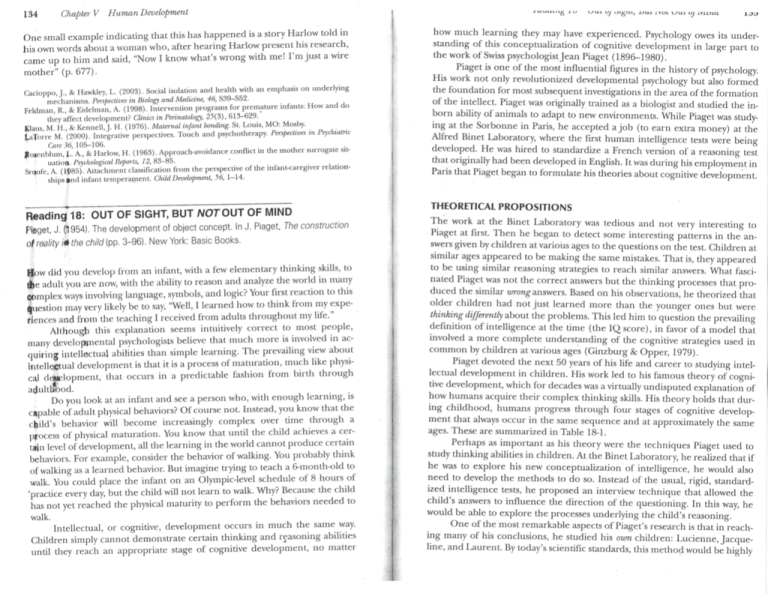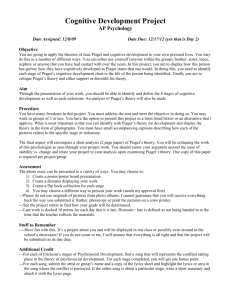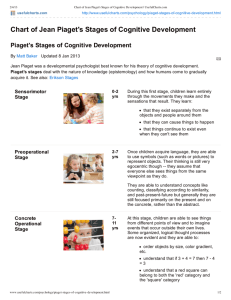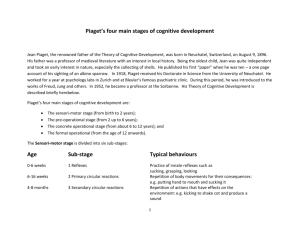
134
Chapter V Human Development
One small example indicating that this has happened is a story Harlow told in
his own words about a woman who, after hearing Harlow present his research,
came up to him and said, "Now I know what's wrong with me! I'm just a wire
mother" (p. 677).
Cacioppo, }., & Hawkley, L. (2003). Social isolation and health with an emphasis on underlying
mechanisms. Perspectives in Biology and Medicine, 46, S39-S52.
Feidman, R., & Eidelman, A. (1998). Intervention programs for premature infants: How and do
they affect development? Clinics in Perinalology, 25(3), 613-629.
Klaus, M. H., & Kennell.J. H. (1976). Maternal infant bonding. St. Louis, MO: Mosby.
LaTorre M. (2000). Inlegrative perspectives. Touch and psychotherapy. Perspectives in Psychiatric
Care, 36, 105-106.
Jlojenblum, L- A., & Harlow, H. (1963). Approach-avoidance conflict in the mother surrogate situation. Psychological Reports, 12, 83-85.
Sroufc, A. (1885). Attachment classification from the perspective of the infant-caregiver relationships fcnd infant temperament. Child Development, 56, 1-14.
Readincj"l8: OUT OF SIGHT, BUT WOT OUT OF MIND
Pisget, J. (1954). The development of object concept. In J. Piaget, The construction
of reality i& the child (pp. 3-96). New York: Basic Books.
How did you develop from an infant, with a few elementary thinking skills, to
the adult you are now, with the ability to reason and analyze the world in many
Complex ways involving language, symbols, and logic? Your first reaction to this
Question may very likely be to say, "Well, I learned how to think from my experiences and from the teaching I received from adults throughout my life."
Although this explanation seems intuitively correct to most people,
many developmental psychologists believe that much more is involved in acquiring intellectual abilities than simple learning. The prevailing view about
intellectual development is that it is a process of maturation, much like physical development, that occurs in a predictable fashion from birth through
adulthood.
Do you look at an infant and see a person who, with enough learning, is
capable of adult physical behaviors? Of course not. Instead, you know that the
child's behavior will become increasingly complex over time through a
process of physical maturation. You know that until the child achieves a certain level of development, all the learning in the world cannot produce certain
behaviors. For example, consider the behavior of walking. You probably think
of walking as a learned behavior. But imagine trying to teach a 6-month-old to
walk. You could place the infant on an Olympic-level schedule of 8 hours of
'practice every day, but the child will not learn to walk. Why? Because the child
has not yet reached the physical maturity to perform the behaviors needed to
walk.
Intellectual, or cognitive, development occurs in much the same way.
Children simply cannot demonstrate certain thinking and reasoning abilities
until they reach an appropriate stage of cognitive development, no matter
J U>t^/t*/t./</i;
J. l_>
vyu.1. L// Ott'tt., l_tU,l, i\Vlj
C'Ut UJ IVlllKA
1*)*)
how much learning they may have experienced. Psychology owes its understanding of this conceptualization of cognitive development in large part to
the work of Swiss psychologist Jean Piaget (1896-1980).
Piaget is one of the most influential figures in the history of psychology.
His work not only revolutionized developmental psychology but also formed
the foundation for most subsequent investigations in the area of the formation
of the intellect. Piaget was originally trained as a biologist and studied the inborn ability of animals to adapt to new environments. While Piaget was studying at the Sorbonne in Paris, he accepted a job (to earn extra money) at the
Alfred Binet Laboratory, where the first human intelligence tests were being
developed. He was hired to standardize a French version of a reasoning test
that originally had been developed in English. It was during his employment in
Paris that Piaget began to formulate his theories about cognitive development.
THEORETICAL PROPOSITIONS
The work at the Binet Laboratory was tedious and not very interesting to
Piaget at first. Then he began to detect some interesting patterns in the answers given by children at various ages to the questions on the test. Children at
Similar ages appeared to be making the same mistakes. That is, they appeared
to be using similar reasoning strategies to reach similar answers. What fascinated Piaget was not the correct answers but the thinking processes that produced the similar wrong-answers. Based on his observations, he theorized that
older children had not just learned more than the younger ones but were
thinking differently about the problems. This led him to question the prevailing
definition of intelligence at the time (the IQ score), in favor of a model that
involved a more complete understanding of the cognitive strategies used in
common by children at various ages (Ginzburg & Opper, 1979).
Piaget devoted the next 50 years of his life and career to studying intellectual development in children. His work led to his famous theory of cognitive development, which for decades was a virtually undisputed explanation of
how humans acquire their complex thinking skills. His theory holds that during childhood, humans progress through four stages of cognitive development that always occur in the same sequence and at approximately the same
ages. These are summarized in Table 18-1.
Perhaps as important as his theory were the techniques Piaget used to
study thinking abilities in children. At the Binet Laboratory, he realized that if
he was to explore his new conceptualization of intelligence, he would also
need to develop the methods to do so. Instead of the usual, rigid, standardized intelligence tests, he proposed an interview technique that allowed the
child's answers to influence the direction of the questioning. In this way, he
would be able to explore the processes underlying the child's reasoning.
One of the most remarkable aspects of Piaget's research is that in reaching many of his conclusions, he studied his own children: Lucienne, Jacqueline, and Laurent. By today's scientific standards, this method would be highly
130
Chapter V Human Development
TABLE 18-1
Piaget's Stages of Cognitive Development
STAGE
AGE RANGE
Sensori-motor
0-2 years
MAJOR CHARACTERISTICS
All knowledge is acquired through senses and movement (such as looking and grasping).
Thinking is at the same speed as physical movement.
Object permanence develops.
Preoperational
2-7 years
Thinking separates from movement and increases
greatly in speed.
1
Ability to think in symbols develops.
1
Nonlogical, "magical" thinking occurs.
1
All objects have thoughts and feelings (animism).
• Egocentric thinking (unable to see world from others'
points of view) develops.
Concrete operations
7-11 years
• Logical thinking develops, including classifying
objects and mathematical principles, but only as they
apply to real, concrete objects.
• Understanding of conservation of liquid, area,
and volume develops.
• Ability develops to infer what others may be feeling
or thinking.
Formal operations
11 and up
• Logical thinking extends to hypothetical and abstract
concepts.
• Ability forms to reason using metaphors and
analogies.
• Ability forms to explore values, beliefs, philosophies.
• Ability forms to think about past and future.
• Not everyone uses formal operations to the same
degree, and some not at all.
suspect because of the rather likely possibility of bias and lack of objectivity.
However, as rules always have exceptions, Piaget's findings from his children
could be applied to all children, universally.
A single chapter in this book is far too little space to explore more than
a small fraction of Piaget's work. Therefore, we will focus on his discovery of
one key intellectual ability, object permanence. This facility provides an excellent
example of one of Piaget's most important findings, as well as ample opportunity to experience his methods of research.
Object permanence refers to your ability to know that an object exists
even when it is hidden from your senses. If someone walks over to you now
and takes this book out of your hands and runs into the next room, do you
think that the book or the book snatcher has ceased to exist? Of course not.
You have a concept of the book and of the person in your mind, even though
you cannot see, hear, or touch them. However, according to Piaget, this was
not always true for you. He demonstrated that your cognitive ability to conceive of objects as permanent and unchanging was something you, and everyone else, developed during your first 2 years of life. The reason this ability is
Heading Id
Out oj'Sight, But Not Out, of Mind
137
important is that problem solving and internal thinking are impossible without it. Therefore, before a child can leave the sensori-motor stage (0 to
2 years; see Table 18-1) and enter the preoperational period (2 to 7 years), object permanence must develop.
METHOD AND RESULTS
Piaget studied the development of object permanence using unstructured evaluation methods: because infants cannot exactly be "interviewed," these techniques often took the form of games he would play with his children.
Through observing problem-solving ability and the errors the infants made
playing the games, Piaget identified six substages of development that occur
during the sensori-motor period and that are involved in the formation of object permanence. For you to experience the flavor of his research, these six
stages are summarized here with examples of Piaget's interactions with his
children quoted from his actual observational journals:
• STAGE 1 (Birth to 1 month). This stage is concerned primarily with reflexes relating to feeding and touching. No evidence of object permanence is seen during this first month of life.
• STAGE 2 (1 to 4 months). During stage 2, although no sign of an object
concept is found, Piaget interprets some behaviors as preparing the infant for this ability. The child begins to repeat, on purpose, certain behaviors that center on the infant's own body. For example, if an infant's
hand accidentally comes in contact with its foot, it might reproduce the
same movements over and over again to cause the event to be repeated.
Piaget called these primary circular reactions. Also, at this stage, infants are
able to follow moving objects with their eyes. If an object leaves the
child's visual field and fails to reappear, the child will turn its attention
to other visible objects and show no signs of looking for the "vanished"
object. However, if the object repeatedly reappears in the same location,
the infant will look longer at that point. Piaget called this behavior
passive expectation. The following interaction between Piaget and his son,
Laurent, illustrates this:
Observation 2. Laurent at 0;2 [0 years, 2 months]. I look at him through
the hood of his bassinet and from time to time I appear at a more or less constant point; Laurent then watches that point when I am out of his sight and obviously expects me to reappear, (p. 9)
The child limits himself to looking at the place where the object vanished:
Thus he merely preserves the attitude of the earlier perception and if nothing
reappears, he soon gives up. If he had the object c o n c e p t . . . he would actively
search to find out where the thing could have been put. . . . But this is precisely
what he does not know how to do, for the vanished object is not yet a permanent
object which has been moved; it is a mere image which reenters the void as soon
as it vanishes, and emerges from it for no objective reason, (p. 11)
• STA GE 3 (4 to 10 months). During this stage children begin to purposefully
and repeatedly manipulate objects they encounter in their environment
138
Chapter V Human Development
(called secondary circular reactions). The child begins to reach for and
grasp things, to shake them, bring them closer to look at them or place
them in the mouth, and to acquire the ability of rapid eye movements to
follow quickly moving or falling objects. Late in this stage, the first signs
of object permanence appear. For example, children begin to search for
objects that are obscured from view if a small part of the object is visible.
Observation 23. At 0;9 I offer Lucienne a celluloid goose which she has
never seen before; she grasps it at once and examines it all over. I place the
goose beside her and cover it before her eyes, sometimes completely, sometimes revealing the head. Two very distinct reactions. . . . When the goose
disappears completely, Lucienne immediately stops searching even when
she is on the point of grasping it. ... When the beak protrudes, not only
does she grasp the visible part and draw the animal to her, but . . . she
sometimes raises the coverlet beforehand in order to grasp the whole
thing! . . . Never, even after having raised the coverlet several times on seeing the beak appear, has Lucienne tried to raise it when the goose was completely hidden! Here . . . is proof of the fact that the reconstruction of a
totality is much easier than the search for an invisible object, (pp. 29-30)
Still, however, Piaget maintains that the object concept is not fully
formed. To the child at this stage, the object does not have an
independent existence but is tied to the child's own actions and sensory
perceptions. In other words, "It would be impossible to say that the halfhidden objective is conceived as being masked by a screen; it is simply
perceived as being in the process of disappearing" (p. 35).
• STAGE 4 (10 to 12 months). In the later weeks of stage 3 and early in stage
4, children have acquired the ability to know that objects continue to
exist even when the objects are no longer visible. A child will search actively and creatively for an object that has been completely hidden from
view. Although on the surface this may seem to indicate a fully developed object concept, Piaget found that this cognitive skill is still incomplete because the child lacks the ability to understand visible displacements.
To understand what Piaget meant by this, consider the following example (you can try this yourself the next time you are a baby around 1 year
old). If you sit with an 11-month-old and hide a toy completely under a
towel (call this place A), the child will search for and find it. However, if
you then hide the toy, as the child watches, under a blanket (place B),
the child will probably go back to searching for it where it was previously
found, in place A. Furthermore, you can repeat this process over and
over and the child will continue to make the same error, which Piaget
called the A-no,t-B effect.
Observation 40. At 0;10 Jacqueline is seated on a mattress . . . I take her
parrot from her hands and hide it twice in succession under the mattress,
on her left, in A. Both times Jacqueline looks for the object immediately
and grabs it. Then I take it from her hands and move it very slowly before
her eyes to the corresponding place on her right, under the mattress, in B.
Jacqueline watches the movement very attentively, but at the moment
when the parrot disappears in B she turns to her left and looks where it
was before, in A. (p. 51)
Piaget's interpretation of this error in stage 4 was not that children
are absentminded but that the object concept is not the same for them as
it is for you or me. To 10-month-old Jacqueline, her parrot is not a permanent, separate thing that exists independently of her actions. When it
was hidden and then successfully found in A, it became a "parrot-in-A.," a
thing that was defined not only by its "parrotness" but also by its hiding
place. In other words, the parrot is just a piece of the overall picture in
the child's mind and not a separate object.
• STAGE 5 (12 to 18 months). Beginning around the end of the first year of
life, the child gains the ability to follow visible sequential displacements
and searches for an object where it was last visibly hidden. When this
happens, Piaget claimed that the child had entered stage 5 of the sensori-motor period.
Observation 54. Laurent, at 0; 11, is seated between two cushions, A and B.
I hide the watch alternately under each; Laurent constantly searches for
the object where it has just disappeared, that is sometimes in A, sometimes
in B, without remaining attached to a privileged position as during the
preceding stage, (p. 67)
However, Piaget points out that true object permanence remains
incomplete because the child is unable to understand what he called
invisible displacements. Imagine the following example: You watch someone place a coin in a small box and then, with his or her back to you, the
person walks over to the dresser and opens a drawer. When the person
returns you discover that the box is empty. This is an invisible displacement of the object. Naturally, you would go to the dresser and look in
the drawer. Piaget and Jacqueline demonstrated this as follows.
Observation 55. At 1;6 Jacqueline is sitting on a green rug and playing
with a potato, which interests her very much (it is a new object for her).
She . . . amuses herself by putting it into an empty box and taking it out
again. I then take the potato and put it in the box while Jacqueline
watches. Then I place the box under the rug and turn it upside down, tiuis
leaving the object hidden by the rug without letting the child see my maneuver, and I bring out the empty box. I say to Jacqueline, who has not
stopped looking at the rug and who realized that I was doing something
under it: "Give Papa the potato." She searches for the object in the box,
looks at me, again looks at the box minutely, looks at the rug, etc., but it
does not occur to her to raise the rug in order to find the potato underneath. During the five subsequent attempts the reaction is uniformly negative, (p. 68)
• STAGE 6 (18 to 24 months). As the child approaches the end of the sensori-motor period (refer back to Table 18-1), the concept of the permanent object becomes fully realized. Entry into this stage is determined by
14U
(Jiapler v
Human ijevewpmeni
the child's ability to represent mentally objects that undergo invisible
displacements.
Observation 66. At 1;7 Jacqueline reveals herself to be ... capable of conceiving of the object under a series of superimposed or encasing screens. . . . I put
die pencil in the box, put a piece of paper around it, wrap this in a handkerchief, then cover the whole thing with die beret and the coverlet. Jacqueline
removes these last two screens, then unfolds die handkerchief. She does not
find the box right away, but continues looking for it, evidently convinced of its
presence; she then perceives the paper, recognizes it immediately, unfolds it,
opens the box, and grasps die pencil, (p. 81)
Piaget considered the cognitive skill of object permanence to be the beginning of true thought: the ability to use insight and mental symbolism
to solve problems. This, then, prepares the child to move into the next
full stage of cognitive development: the preoperationalperiod, during which
thought separates from action, allowing the speed of mental operations
to increase greatly. In other words, object permanence is the foundation
for all subsequent advances in intellectual ability. As Piaget stated:
The conservation of the object is, among other things, a function of its localization; dial is, the child simultaneously learns that the object does not cease
to exist when it disappears and he learns where it does go. This fact shows
from the outset that the formation of the schema of the permanent object is
closely related to die whole spatio-temporal and causal organization of the
practical universe. (Piaget & Inhelder, 1969)
DISCUSSION
This method of exercises and observation of behavior formed the basis of
Piaget's work throughout his formulation of all four stages of cognitive development. Piaget contended that all of his stages applied universally to all
children, regardless of cultural or family background. In addition, he
stressed several important aspects relating to the stages of development of
the object concept during the sensori-motor period (see Ginzburg & Opper,
1979, for an elaboration of these points).
1. The ages associated with each stage are approximate. Because Piaget's
early work only involved three children, it was difficult for him to predict
age ranges with a great deal of confidence. For example, certain abilities
he observed in Jacqueline at age 1;7 were present in Lucienne at 1;3.
2. Piaget maintained, however, that the sequence of the stages was invariant. All children must pass through each stage before going on to the
next, and no stage can ever be skipped.
3. Changes from one stage to the next occur gradually over time so that
the errors being made at one stage slowly begin to decrease as new intellectual abilities mature. Piaget believed that it is quite common and normal for children to be between stages and exhibiting abilities from
earlier and later stages at the same time.
Keaamg I y
Out of Sight, But Not Out of Mind
141
4. As a child moves into the next higher stage, the behaviors associated
with the lower stages do not necessarily disappear completely. It would
not be unusual for a child in stage 6 to apply intellectual strategies used
in stage 5. Then when these prove unsuccessful, the child will invoke
new methods for solving the problem typical of stage 6 reasoning.
CRITICISMS AND RECENT APPLICATIONS
Although Piaget's conceptualization of cognitive development dominated the
field of developmental psychology for several decades, his view has certainly
not been without critics. Some of them have questioned Piaget's basic notion
that cognitive development happens in discrete stages. Many learning theorists have disagreed with Piaget on this issue and contend that intellectual development is continuous, without any particular sequence built into the
process. They believe that cognitive abilities, like all other behaviors, are a result of modeling and a person's learning and conditioning history.
Other critics of Piaget's ideas have claimed that the age ranges at which
he asserted specific abilities appear are incorrect, and some even argue that
certain cognitive skills may already be present at birth. Object permanence is
one of those abilities that has been drawn into question. In a series of ingenious studies using research techniques known as preference looking (see Reading 5 on Fantz's discovery of this research methodology), developmental
psychologist Renee Baillargeon and her associates have demonstrated that infants as young as 2'/i months of age appear to possess early forms of object permanence (Aguilar & Baillargeon, 1999; Baillargeon, 1987). She and others
have asserted that Piaget's methods were inadequate to measure accurately
the abilities of very young infants because they required motor skills that infants do not possess.
Piaget's concepts and discoveries have influenced research in a wide
variety of fields. This is evidenced by the fact that more than 50 scientific articles each year cite the book by Piaget that forms the basis for this discussion. For example, one study compared 6Vz-month-old infants' tendency to
search for objects hidden by darkness to their tendency to search for objects
hidden under a cloth in the light, as in Piaget's games with his children
(Shinskey & Munakata, 2003). Interestingly, the researchers found that the
infants were better at looking for objects in the dark compared to searching
for them when the objects were covered by a cloth in the light. Why would
this be true? One explanation may be that the appearance of the cloth interferes with the infants' new, fragile ability to represent the object mentally.
An alternate explanation may be that our ability to think about, and search
for, objects in (potentially dangerous) darkness was more adaptive from an
evolutionary, survival perspective than doing so when items are merely hidden in the light.
Another fascinating study relating to Piaget's work found an association between infants' ability to differentiate among objects and their comprehension of
the words for the objects (Rivera & Zawaydeh, 2007). Using preference-looking
I'iZ
v
i-tuma't
techniques, this study revealed that infants at only 10 or 11 months of age were
able to differentiate between objects only if they understood the words for both
objects. The authors propose that 'These results suggest that comprehending
the words for occluded/disoccluded [hidden and revealed] objects provides a
kind of 'glue' which allows infants to bind the mental index of an object with its
perceptual features (thus precipitating the formation of two mental indexes,
rather than one)" (p. 146). That is, knowing the names for objects appears to
help infants mentally store an image of an object as unique and recognizable in
comparison with other objects.
An intriguing study citing Piaget's work on object permanence found an
association between development of the object concept and sleep in 9-monthold infants (Scher, Amir, & Tirosh, 2000). These findings indicated that infants with a more advanced grasp of object permanence experienced
significantly fewer sleep difficulties than those with lower levels of the object
concept. This may make a certain intuitive sense, if you think about it. If you
were not sure all your stuff would still exist in the morning, you probably
wouldn't sleep very well either!
CONCLUSION
As methods have been refined for studying infants' cognitive abilities, such as
preference-looking and habituation-dishabituation techniques, some of Piaget's discoveries are being drawn into question (for more information about
these research methods, see Reading 5 on Fantz in this book; also, Craig &
Dunn, 2007). In fact, numerous ongoing controversies surrounding Piaget's
theory of cognitive development are swirling through the field of developmental psychology. Such controversy is healthy; it motivates discussion and research that will eventually lead to even greater understanding and knowledge
about the sources and growth of human cognition.
Controversy notwithstanding, Piaget's theory remains the catalyst and
foundation for all related research. His work continues to guide enlightened
people's ideas about research with children, methods of education, and styles
of parenting. Piaget's contribution was and is immeasurable.
AguiUir, A., & Baillargeon, R. (1999). 2.5-month-old infants' reasoning about when objects should
and should not be occluded. Cognitive Psychology, 39(2), 116-157.
Baillargeon, R. (1987). Object permanence in 3'/4- and 41/S-month-old infants. Developmental
Psychology, 23, 655-664.
Craig, G., & Dunn, W. (2007). Understanding human development. Upper Saddle River, NJ: Pearson
Prentice Hall.
Ginzburg, H., & Opper, S. (1979). Piaget's theory of intellectual development. Englewood Cliffs, NJ:
Prentice-Hall.
Piaget, J., & Inhelder, B. (1969). The psychology oftherMld. New York: Basic Books.
Rivera, S., & Zawaydeh, A.N. (2007). Word comprehension facilitates object individuation in 10and ll-mon th-old infants. Brain Research, 1146, 146-157.
Scher, A\, Amir, T., & Tirosh, E. (2000). Object concept and sleep regulation. Perceptual and Motor
Skins, 91 (2), 402-404.
Shinskfy, ]., & Munakata, Y. (2003). Are infants in the dark about hidden objects? Developmental
. Science, 6, 273-282.
neaamg i y
now moral Are You ?
143
Reading 19: HOW MORAL ARE YOU?
Kohlberg, L. (1963). The development of children's orientations toward a moral
order: Sequence in the development of moral thought. Vita Humana, 6, 11-33.
Have you ever really thought about how moral you are compared to others?
What are the moral principles guiding your decisions in life? Experience
should tell you that people's morality varies a great deal. Psychologists generally define morals as those attitudes and beliefs tiiat help people decide the difference between and degrees of right and wrong. Your concept of morality is
determined by the rules and norms of conduct that are set forth by the culture
in which you have been raised and that have been internalized by you. Morality
is not part of your standard equipment at birth: you were probably born without morals. As you developed through childhood into adolescence and adulthood, your ideas about right and wrong developed along with you. Every
normal adult has a personal conception of morality. But where did your morality originate? How did it go from a set of cultural rules to part of who you are?
Probably the two most famous and influential figures in the history of research on the formation of morality were Jean Piaget (discussed in Reading 18)
and Lawrence Kohlberg (1927-1987). Kohlberg's research at the University of
Chicago incorporated and expanded upon many of Piaget's ideas about intellectual development and sparked a new wave of interest in this topic of study.
Kohlberg was addressing this question: "How does the amoral infant become capable of moral reasoning?"
Using the work of Piaget as a starting point, Kohlberg theorized that the
uniquely human ability to make moral judgments develops in a predictable way
during childhood. He believed that specific, identifiable stages of moral development are related and similar in concept to Piaget's stages of intellectual development. As Kohlberg explained, "The child can internalize the moral values
of his parents and culture and make them his own only as he comes to relate
these values to a comprehended social order and to his own goals as a social
self (Kohlberg, 1964). In other words, a child must reach a certain stage of intellectual ability in order to develop a certain level of morality.
With these ideas in mind, Kohlberg set about formulating a method for
studying children's abilities to make moral judgments. From that research
grew his widely recognized theory of moral development.
THEORETICAL PROPOSITIONS
When Kohlberg asserted that morality is acquired in developmental stages, he
was using the concept of stage in a precise and formal way. It is easy to think of
nearly any ability as occurring in stages, but psychologists draw a clear distinction
between changes that develop gradually over time (such as a person's height)
and those that develop in distinct and separate stages. So when Kohlberg referred to "structural moral stages in childhood and adolescence," he meant dial
(a) each stage is a uniquely different kind of moral thinking and not just an









